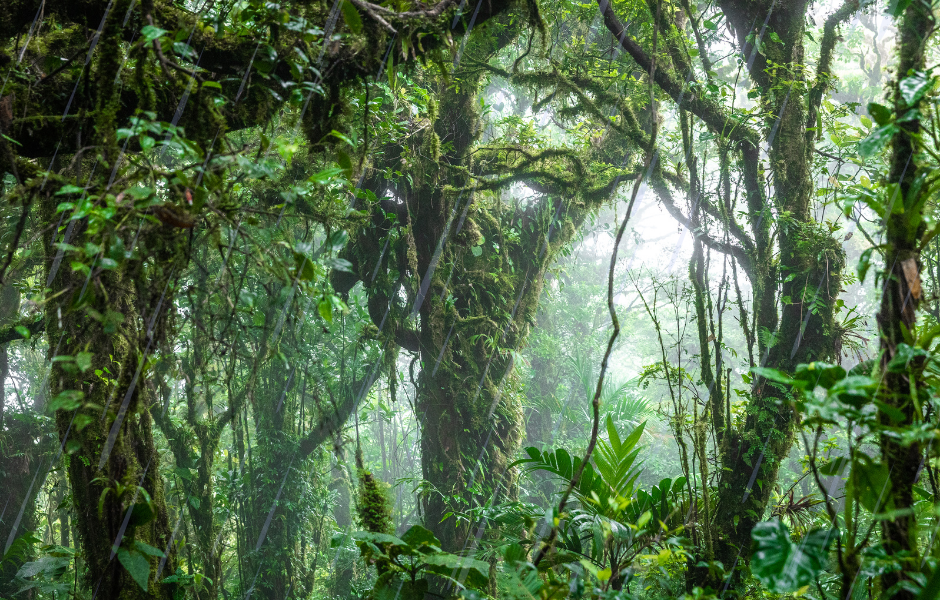
This children’s article, What is a cloud forest? The misty forests of the mountains, has been written for native English speakers and learners of English as a second or foreign language. It can help children practise reading and comprehension, learn useful vocabulary, and discover one of the most magical forest types on Earth. Written by Sinead O’Carroll, an experienced teacher and writer.
A forest in the clouds?
High up in the mountains, where the air is cool and the clouds drift low through the trees, there’s a rare and mysterious kind of forest. It’s called a cloud forest.
These forests are always damp and misty. Rain falls almost every day. But it doesn’t always fall from the sky – sometimes the clouds themselves roll through the trees, covering everything in tiny drops of water.
You can find cloud forests in warm mountain regions across the world, from Costa Rica and Peru to parts of Africa, Asia, and Australia. But they’re not common. Only certain mountains have just the right mix of moisture, height, and temperature to grow one.
What makes them special?
Cloud forests are tropical forests, similar to rainforests. However, rainforests grow in low, hot places, while cloud forests grow higher up, where it’s cooler. They are usually found between 1,000 and 2,500 metres above sea level.
Because the air is always damp with mist and rain, cloud forests are full of soft green moss, twisty vines, and leafy ferns that grow everywhere.
Many plants live high up on tree branches instead of on the ground. These plants don’t even need soil – there’s so much water in the mist and air that they can drink straight from it!
Animals in cloud forests
Lots of animals live in cloud forests too, including some that don’t live anywhere else on Earth.
You might find colourful birds, rare frogs, and even kangaroos that live in trees! In Africa, mountain gorillas live in some cloud forests.
A forest that makes rain
Cloud forests don’t just collect water – they help create it. The trees trap moisture from the air, which helps form clouds and keeps rivers flowing below. Even when it’s not raining, people living far away still get clean water thanks to the cloud forest.
That’s why these forests are so important for nature and for people.
A vanishing world
Sadly, cloud forests are in danger. Many are being cut down to make space for farming or to use the trees for timber. Because cloud forests grow slowly and only in certain places, it’s very hard to replace them.
Climate change is another big threat. As the world gets warmer, some mountains may lose their clouds. That means the cloud forests could dry out, and the animals, plants, and people who depend on them could be at risk.
Scientists are still exploring cloud forests, and they’re discovering new species all the time. If we don’t protect these amazing places, their secrets could disappear before we even find them.
To learn more about cloud forests, check out the Geo Explainer: Cloud Forests.

Article vocabulary list
- Mist – tiny drops of water in the air, like a light fog
- Altitude – how high something is above sea level
- Moisture – water in the air or in something
- Species – a group of living things that are alike and can have babies
- Tropical – a warm part of the world near the equator
- Moss – a soft green plant that grows in damp places
- Soil – the top layer of earth where plants grow
- Timber – wood from trees used to build or make things
Comprehension questions
Just click the plus (+) to see the answer
1. What is a cloud forest?
a) A forest made of clouds
b) A forest that grows in hot deserts
c) A forest in the mountains that is often covered in clouds
Answer: c) A forest in the mountains that is often covered in clouds
2. Where are cloud forests usually found?
Answer: In warm mountain regions between 1,000 and 2,500 metres above sea level
3. How are cloud forests different from rainforests?
Answer: They grow higher up in cooler places and are often covered in mist
4. Why can some plants grow on tree branches in cloud forests?
a) Because the trees have special soil
b) Because there is so much moisture in the air
c) Because they don’t need sunlight
Answer: b) Because there is so much moisture in the air
5. What kind of animals might live in cloud forests?
Answer: Birds, frogs, mountain gorillas, and even tree kangaroos
6. How do cloud forests help people who live far away?
Answer: They collect water and help rivers keep flowing, even when it doesn’t rain
7. What are two big threats to cloud forests?
Answer: Deforestation (cutting down trees) and climate change
8. Why is it important to protect cloud forests?
Answer: Because they provide water, support rare animals and plants, and scientists are still discovering new things about them
Sinead is a writer and EFL teacher with eight years’ experience. She’s a native English speaker who loves making news stories fun and easy to understand for children around the world. Her passions include travel, animals, and helping to make the world a kinder, more sustainable place.




